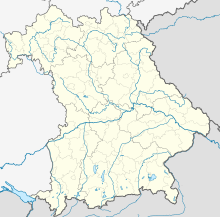Battle of the Alte Veste
This article may be expanded with text translated from the corresponding article in German. (November 2019) Click [show] for important translation instructions.
|
This article needs additional citations for verification. (September 2008) |
Coordinates: 49°27′11.5″N 10°57′54″E / 49.453194°N 10.96500°E
| Battle of Alte Veste | |||||||
|---|---|---|---|---|---|---|---|
| Part of the Swedish intervention in the Thirty Years' War | |||||||
 Plan of Wallenstein's camp, made in 1634 | |||||||
| |||||||
| Belligerents | |||||||
|
|
| ||||||
| Commanders and leaders | |||||||
| Albrecht von Wallenstein |
Gustavus Adolphus Lennart Torstensson (POW) | ||||||
| Strength | |||||||
| 43,500 men[1] |
44,600 men 30,011 infantry in 37 regiments and 306 companies. 15,419 cavalry in 39 regiments and 263+ companies[2] | ||||||
| Casualties and losses | |||||||
|
1,400[1] 400 killed, 1,000 wounded |
2,400[3] 1,000 killed, 1,400 seriously wounded | ||||||
 Alte Veste, Zirndorf | |||||||
The Battle of the Alte Veste was a significant battle of the Thirty Years' War.
Background[]
In the late summer of 1632 the army of Swedish King Gustavus Adolphus met Albrecht von Wallenstein near Nürnberg. The successes of Gustavus Adolphus over General Tilly forced Holy Roman Emperor Ferdinand II to recall Albrecht von Wallenstein into military service from retirement. Wallenstein was unmatched in his ability to raise troops, and within a few weeks he took to the field with a fresh army.
The Imperial Army's ranks swelled as Wallenstein moved to stop the Swedes' advance at Nuremberg. Repeatedly, Gustav Adolf formed for battle and challenged Wallenstein to come out of his fortified camp, but was refused. As the supply situation continued to worsen, the impetuous King grew desperate.
Battle[]
He attacked the Imperial camp at the Alte Veste (or "Old Fortress")—a derelict castle situated atop a wooded hill. Its ownership would then allow the Swedish guns to dominate the Imperial camp. The Imperials were prepared with trenches and an abatis that stymied the Swedish advance. When the vaunted brigades faltered, much of the cavalry was sent in dismounted. Wallenstein saw an opportunity to strike a blow and sallied his cavalry and cut down many of the exhausted troops. Only the final introduction of the Swedish cavalry reserve averted a complete disaster.

Result[]
The Swedes had been defeated. The Commander of the Swedish artillery, Lennart Torstenson, was taken prisoner and locked up for nearly a year at Ingolstadt. Gustav Adolf received reinforcements in early September, and once again unsuccessfully attempted to break the siege at the Battle of Fürth on 3 September (n.s.). Several weeks later, lack of supplies led Wallenstein to break camp and move north, allowing the Swedish forces out of Nuremberg. The two armies met again the following six weeks later at the disastrous Battle of Lützen, in which Gustavus Adolphus was killed.
Citations[]
- ^ a b Clodfelter 2017, p. 40.
- ^ "Archived copy" (PDF). Archived from the original (PDF) on 2016-04-12. Retrieved 2016-03-07.
{{cite web}}: CS1 maint: archived copy as title (link) - ^ Wilson 2009, p. 506.
References[]
- Clodfelter, M. (2017). Warfare and Armed Conflicts: A Statistical Encyclopedia of Casualty and Other Figures, 1492–2015 (4th ed.). Jefferson, North Carolina: McFarland. ISBN 978-0786474707.
- Wilson, Peter H. (2009). Europe's Tragedy: A History of the Thirty Years War. Allen Lane. ISBN 978-0-7139-9592-3.
External links[]
 Media related to Battle of the Alte Veste at Wikimedia Commons
Media related to Battle of the Alte Veste at Wikimedia Commons
- Conflicts in 1632
- 1632 in Europe
- Battles involving Sweden
- Battles of the Thirty Years' War
- Battles involving the Holy Roman Empire
- 1632 in the Holy Roman Empire
- Events in Nuremberg
- Gustavus Adolphus of Sweden
- Albrecht von Wallenstein
- Battles in Bavaria

